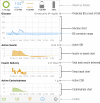Realizing a Closed-Loop (Artificial Pancreas) System for the Treatment of Type 1 Diabetes
- PMID: 31276160
- PMCID: PMC6821212
- DOI: 10.1210/er.2018-00174
Realizing a Closed-Loop (Artificial Pancreas) System for the Treatment of Type 1 Diabetes
Abstract
Recent, rapid changes in the treatment of type 1 diabetes have allowed for commercialization of an "artificial pancreas" that is better described as a closed-loop controller of insulin delivery. This review presents the current state of closed-loop control systems and expected future developments with a discussion of the human factor issues in allowing automation of glucose control. The goal of these systems is to minimize or prevent both short-term and long-term complications from diabetes and to decrease the daily burden of managing diabetes. The closed-loop systems are generally very effective and safe at night, have allowed for improved sleep, and have decreased the burden of diabetes management overnight. However, there are still significant barriers to achieving excellent daytime glucose control while simultaneously decreasing the burden of daytime diabetes management. These systems use a subcutaneous continuous glucose sensor, an algorithm that accounts for the current glucose and rate of change of the glucose, and the amount of insulin that has already been delivered to safely deliver insulin to control hyperglycemia, while minimizing the risk of hypoglycemia. The future challenge will be to allow for full closed-loop control with minimal burden on the patient during the day, alleviating meal announcements, carbohydrate counting, alerts, and maintenance. The human factors involved with interfacing with a closed-loop system and allowing the system to take control of diabetes management are significant. It is important to find a balance between enthusiasm and realistic expectations and experiences with the closed-loop system.
Copyright © 2019 Endocrine Society.
Figures






References
-
- Tamborlane WV, Sherwin RS, Genel M, Felig P. Reduction to normal of plasma glucose in juvenile diabetes by subcutaneous administration of insulin with a portable infusion pump. N Engl J Med. 1979;300(11):573–578. - PubMed
-
- Johnson SR, Cooper MN, Jones TW, Davis EA. Long-term outcome of insulin pump therapy in children with type 1 diabetes assessed in a large population-based case-control study. Diabetologia. 2013;56(11):2392–2400. - PubMed
-
- Nathan DM, Genuth S, Lachin J, Cleary P, Crofford O, Davis M, Rand L, Siebert C; Diabetes Control and Complications Trial Research Group. The effect of intensive treatment of diabetes on the development and progression of long-term complications in insulin-dependent diabetes mellitus. N Engl J Med. 1993;329(14):977–986. - PubMed
Publication types
MeSH terms
Substances
Grants and funding
LinkOut - more resources
Full Text Sources
Other Literature Sources
Medical

